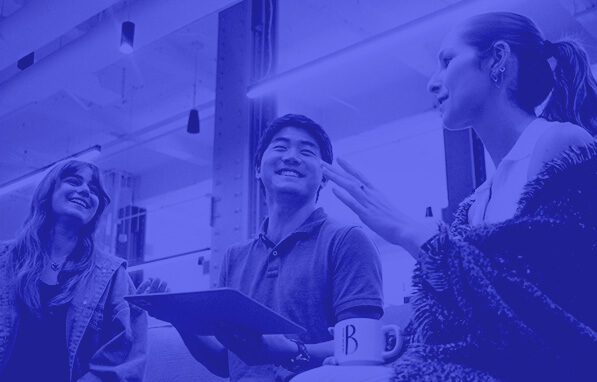Is AI Taking Over the Creative World?
From a social-first approach to new creative cloud innovations, here are 4 tips we’ve gathered from Adobe MAX on how graphic designers can navigate an AI-enabled world.
1. AI in Creativity: A Tool, Not a Replacement
AI tools enhance efficiency, but the heart of design lies in human creativity — which cannot be replaced. At Adobe MAX, new innovations emphasized how AI tools empower designers to take creative risks that were previously “too time consuming or expensive.” As a concepting tool, AI helps designers explore ideas more fully and present detailed concepts to clients during the ideation stage.
Adobe’s latest innovations presented at Adobe MAX streamline workflows across Photoshop, Illustrator, and Premiere Pro. Photoshop’s Generative Workspace (beta) simplifies concept development with features like Generative Fill, Expand, and Background, powered by Adobe Firefly. With new tools like Distraction Removal, users can quickly eliminate unwanted elements, such as subjects, wires, or cables. Illustrator introduces Objects on Path, Enhanced Image Trace, and Generative Shape Fill (beta), driven by the Firefly Vector Model, to further optimize design workflows. Premiere Pro’s (beta) Generative Extend feature ensures smoother edits by filling gaps and seamlessly adjusting shot lengths.
While these new AI tools open creative possibilities and efficiency, meaningful design still comes from the human qualities of intention and creativity.
2. Being Intentional with Your Craft
Being intentional with your work means approaching every task with purpose, thoughtfulness, and alignment to your creative vision. It’s about making deliberate choices, including taking breaks, actively looking for resources to progress in your craft, and dedicating hours to concepts and ideas.
Thoughtful work requires considering the impact and meaning behind your work and how it relates back to you. Ask yourself why you’re doing something and how you can refine your process to focus on yourself. Creating is not about speed, but the steps it takes to get to that final product.
Purposeful work is driven by a clear objective. Focus on long-term goals rather than quick wins, ensuring that each decision brings you closer to those outcomes.
In short, intentionality is about working with meaning, ensuring that every action serves a purpose and supports your creative direction, rather than being reactive or scattered.
3. Beating the Algorithm: Working Smarter, Not Harder
“Beating the algorithm” can be challenging, but a social-first approach can make a difference. Social-first means prioritizing social media because people want to be heard — and it’s a proven strategy. Brands using social insights as a driver can see up to an 8x increase in revenue, with many now positioning social media at the core of their customer experience.
The key to this approach is user-generated content and active participation in online communities – taking consumer feedback seriously can strengthen a brand. For instance, a Korean skincare brand responded to an influencer’s criticism about limited product shades by adding 30 additional shades and sending them to the influencer. This not only increased engagement but also earned them credibility.
4. Reimagining Design with Intent: Bringing Ideas to Life
AI has unlocked design possibilities that were once out of reach, enabling designers to explore complex visuals and automate tedious tasks. Adobe has explored this in their programs, turning what once were time consuming processes into clicks of a button. However, the real power comes from the designer’s intent. AI is a tool, but the designer’s vision and purpose shape the outcome.
One way to center intent is creating comps (comprehensive layouts). Comps allow designers to refine their initial ideas into clear, intentional visual concepts. They serve as a bridge between abstract thoughts and fully realized designs, helping align creative instinct with purpose. This process ensures that the final product not only looks polished but also communicates the designer’s vision effectively. In this way, while AI can assist with execution in the details, it’s the intentional design choices made by the designer that bring ideas to life in a meaningful way. The designer is the guiding hand when it comes to using these AI tools.
AI is a powerful tool that can enhance creativity, speeding up workflows and expanding design possibilities. But it’s the intentionality of the designer that leads to meaningful and impactful work.
As you embrace AI in your work, stay grounded in your creative purpose. Technology can assist and enhance your process, but never lose sight of your own artistic direction and values.
By Lauren Roderigues & Merna Ahmed
Photo by Bruno Thethe via Pexels
